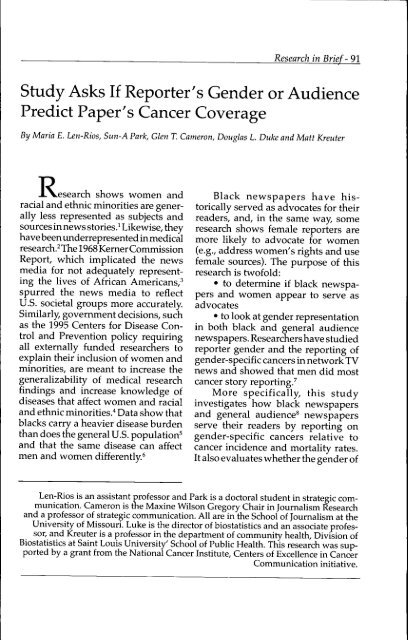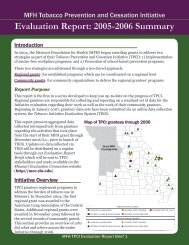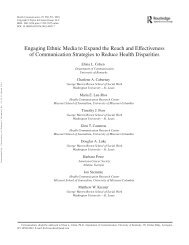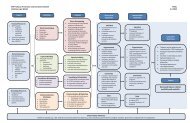Study Asks If Reporter's Gender or Audience Predict Paper's Cancer ...
Study Asks If Reporter's Gender or Audience Predict Paper's Cancer ...
Study Asks If Reporter's Gender or Audience Predict Paper's Cancer ...
You also want an ePaper? Increase the reach of your titles
YUMPU automatically turns print PDFs into web optimized ePapers that Google loves.
Research in Brief- 91<strong>Study</strong> <strong>Asks</strong> <strong>If</strong> <strong>Rep<strong>or</strong>ter's</strong> <strong>Gender</strong> <strong>or</strong> <strong>Audience</strong><strong>Predict</strong> <strong>Paper's</strong> <strong>Cancer</strong> CoverageBy Maria E. Len-Rios, Sun-A Park, Glen T. Cameron, Douglas L. Duke and Matt KreuterReresearch shows women andracial and ethnic min<strong>or</strong>ities are generallyless represented as subjects andsources in news st<strong>or</strong>ies.* Likewise, theyhave been underrepresented in medicalresearch.^ The 1968 Kemer CommissionRep<strong>or</strong>t, which implicated the newsmedia f<strong>or</strong> not adequately representingthe lives of African Americans,^spurred the news media to reflectU.S. societal groups m<strong>or</strong>e accurately.Similarly, government decisions, suchas the 1995 Centers f<strong>or</strong> Disease Controland Prevention policy requiringall externally funded researchers toexplain their inclusion of women andmin<strong>or</strong>ities, are meant to increase thegeneralizability of medical researchfindings and increase knowledge ofdiseases that affect women and racialand ethnic min<strong>or</strong>ities."* Data show thatblacks carry a heavier disease burdenthan does the general U.S. population^and that the same disease can affectmen and women differently.*^Black newspapers have hist<strong>or</strong>icallyserved as advocates f<strong>or</strong> theirreaders, and, in the same way, someresearch shows female rep<strong>or</strong>ters arem<strong>or</strong>e likely to advocate f<strong>or</strong> women(e.g., address women's rights and usefemale sources). The purpose of thisresearch is twofold:• to determine if black newspapersand women appear to serve asadvocates• to look at gender representationin both black and general audiencenewspapers. Researchers have studiedrep<strong>or</strong>ter gender and the rep<strong>or</strong>ting ofgender-speciHc cancers in netw<strong>or</strong>k TVnews and showed that men did mostcancer st<strong>or</strong>y rep<strong>or</strong>ting.^M<strong>or</strong>e specifically, this studyinvestigates how black newspapersand general audience' newspapersserve their readers by rep<strong>or</strong>ting ongender-specific cancers relative tocancer incidence and m<strong>or</strong>tality rates.It also evaluates whether the gender ofLen-Rios is an assistant profess<strong>or</strong> and Park is a doct<strong>or</strong>al student in strategic communication.Cameron is the Maxine Wilson Greg<strong>or</strong>y Chair in Journalism Researchand a profess<strong>or</strong> of strategic communication. All are in the School of Journalism at theUniversity of Missouri. Luke is the direct<strong>or</strong> of biostatistics and an associate profess<strong>or</strong>,and Kreuter is a profess<strong>or</strong> in the department of community health. Division ofBiostatistics at Saint Louis University' School of Public Health. This research was supp<strong>or</strong>tedby a grant from the National <strong>Cancer</strong> Institute, Centers of Excellence in <strong>Cancer</strong>Communication initiative.
92 - Newspaper Research Journal • Vol. 29, No. 2 • Spring 2008the rep<strong>or</strong>ter is associated with cancerrep<strong>or</strong>ting, rep<strong>or</strong>ting of gender-specificcancers and the use of female st<strong>or</strong>ysources. Considering rep<strong>or</strong>ter genderis imp<strong>or</strong>tant because it is associatedwith st<strong>or</strong>y tone, content and use of agreater diversity of sources.'<strong>Cancer</strong> is second only to heart diseaseas a cause of U.S. death.'" Prostatecancer and breast cancer are the mostcommon gender-specific cancers." Estimatesfrom 2007 showed 29 percentof all men and 37 percent of black menwere diagnosed with prostate cancer.Additionally, prostate cancer accountedf<strong>or</strong> 9 percent of cancer deaths in allmen and 13 percent of cancer deathsin black men. In 2007,26 percent of allU.S. women and 27 percent of blackwomen were diagnosed with breastcancer. Breast cancer caused 15 percentof cancer deaths in all women and 19percent in black women.'^ Black menhave a higher incidence of prostatecancer, and men overall are diagnosedm<strong>or</strong>e often with a gender-specificcancer than are women. Still, genderspecificcancers kill m<strong>or</strong>e women.Figures from 2006 specify therewere 237 black newspapers,"similarto 1986 figures.'" Surveys demonstratethat African-American publishers andedit<strong>or</strong>s believe that their unique contentdistinguishes them from generalaudience newspapers.'^ This view isshared by their readers."" One surveyrevealed that 68 percent of AfricanAmericans rep<strong>or</strong>t reading a blacknewspaper.'^ A N<strong>or</strong>th Carolina surveyshowed that black newspaper readerswere also m<strong>or</strong>e likely to read a localnewspaper.'^Black newspapers may be a valuablehealth news source f<strong>or</strong> black readers.In a survey of black newspaperreaders, 80 percent said they read st<strong>or</strong>iesthat addressed black health risks;67 percent said st<strong>or</strong>ies had influencedthem to alter a health habit."Few studies specifically addresscancer coverage in the black press.Studies of Canadian ethnic cancer newssuggested that content is culturallytail<strong>or</strong>ed^" and that ethnic groups selectivelygather cancer inf<strong>or</strong>mation.^' OneU.S. study that compared mainstreamnewspapers with ethnic newspapersfound that ethnic newspapers focusedm<strong>or</strong>e on prevention and that bothnewspaper types emphasized cancertreatments and breast cancer.^^Rep<strong>or</strong>ter gender has been linked togender representation in news st<strong>or</strong>ies,source selection and the rep<strong>or</strong>ting qualityof gendered topics. Pri<strong>or</strong> researchshows that women appear less often innews than do men. Len-Rios, Rodgers,Th<strong>or</strong>son and Yoon^ studied two metropolitandailies and found that womenwere represented in 18-21 percentof news st<strong>or</strong>ies and 27-30 percent ofnews photos. Other studies have foundsimilar underrepresentation.^"Research also shows that rep<strong>or</strong>tergender matters in st<strong>or</strong>y sourcingbecause female rep<strong>or</strong>ters were m<strong>or</strong>elikely to use female sources than weremales.^^ As Zoch and Turk^* have argued,when women do not appear inst<strong>or</strong>ies as sources, it sends "a signalto the reader that they are relativelyunimp<strong>or</strong>tant."Studies also have examinedwhether rep<strong>or</strong>ter gender affects thetreatment of news topics. Merritt andGross^^ studied lifestyle sections andfound that female rep<strong>or</strong>ters wrote m<strong>or</strong>eabout the women's movement and men
Research in Brief- 93wrote m<strong>or</strong>e about leisure topics.Some studies have found that femalerep<strong>or</strong>ters do not represent womenm<strong>or</strong>e frequently <strong>or</strong> better than malerep<strong>or</strong>ters. Liebler and Smith^** studiedgender in TV news and concludedthat both female and male rep<strong>or</strong>tersrep<strong>or</strong>ted st<strong>or</strong>ies in the same manner.Lavie and Lehman-Wilzig^' discovereda lack of gender differences in newsvalues among Israeli news edit<strong>or</strong>s.Researchers have offered reasonsf<strong>or</strong> these discrepancies, includingnewsroom pressures, economic fact<strong>or</strong>sand rep<strong>or</strong>ter socialization.^" Craftand Wanta^^ suggest that the gender oftop management matters. Everbach's^^research of a newspaper with an allfemale management team concludedthat female news managers influencednews sections where there were m<strong>or</strong>estaff st<strong>or</strong>ies rather than news frontsections.Few studies address rep<strong>or</strong>tergender and gender-specific cancers.C<strong>or</strong>bett and M<strong>or</strong>i^^ looked at nationalTV news st<strong>or</strong>ies and found that malerep<strong>or</strong>ters (75 percent) rep<strong>or</strong>ted m<strong>or</strong>egender-specific cancer st<strong>or</strong>ies than didfemale rep<strong>or</strong>ters (25 percent). Malerep<strong>or</strong>ters also delivered both male andfemale cancer st<strong>or</strong>ies, whereas femalerep<strong>or</strong>ters almost always deliveredfemale cancer st<strong>or</strong>ies.Research QuestionsBased on these findings it is notclear how gender-specific cancer st<strong>or</strong>iesmay be rep<strong>or</strong>ted in general audienceand black newspapers, so the followingresearch questions are presented:what is the prop<strong>or</strong>tion of journalists,male v. female, who write aboutcancer in general audience and blacknewspapers?RQ2a:Are female rep<strong>or</strong>ters m<strong>or</strong>e likely t<strong>or</strong>ep<strong>or</strong>t on breast cancer than are malerep<strong>or</strong>ters in black newspapers andgeneral audience newspapers?RQ2b:Are male rep<strong>or</strong>ters m<strong>or</strong>e likelyto rep<strong>or</strong>t on prostate cancer than arefemale rep<strong>or</strong>ters in black newspapersand general audience newspapers?RQ3:Does the coverage of genderspecificcancer in black and generalaudience newspapers reflect the actualU.S. incidence <strong>or</strong> m<strong>or</strong>tality rates f<strong>or</strong>cancer?RQ4:Is the gender of the rep<strong>or</strong>ter associatedwith the gender of the rep<strong>or</strong>tr ter's '-primary source?MethodSampleThe data are from a large contentanalysis of black and generalaudience newspapers.^ This study'ssample includes health news st<strong>or</strong>iesf<strong>or</strong> a 17-month period between April1, 2004, and Aug. 28, 2005.^5 A total ofN=7,318 st<strong>or</strong>ies was initially selectedas general health st<strong>or</strong>ies from 36 newspapers—24black newspapers and 12community-matched general audiencenewspapers.^* Of these, 1,559 st<strong>or</strong>ies
94 - Newspaper Research Journal • Vol. 29, No. 2 • Spring 2008were identified as staff st<strong>or</strong>ies—1,056from general audience newspapers and503 from black newspapers. Of those,cancer was the primary topic of 198st<strong>or</strong>ies—131 (66.2 percent) from generalaudience new^spapers and 67 (33.8percent) from black newspapers.Coding Analysis and Categ<strong>or</strong>iesCoding included reading thenewspaper articles and classifyingst<strong>or</strong>ies as health st<strong>or</strong>ies. Next, trainedcoders applied the coding instrument.Krippend<strong>or</strong>f's alpha is rep<strong>or</strong>ted as thereliability estimate f<strong>or</strong> each variablecoded.VariablesSt<strong>or</strong>y source. St<strong>or</strong>ies were coded as"staff st<strong>or</strong>ies," "wire st<strong>or</strong>ies," "both" <strong>or</strong>"other." Only staff st<strong>or</strong>ies were used inthis analysis. The reliability was .78.Health topic. St<strong>or</strong>ies were selectedas cancer st<strong>or</strong>ies if the w<strong>or</strong>d "cancer"<strong>or</strong> the terms: "carcinogen," "lump,""malignant," "neoplasm," "oncology,""tum<strong>or</strong>" <strong>or</strong> other variations of theseterms appeared in the headline <strong>or</strong> firsttwo paragraphs of the st<strong>or</strong>y. The reliabilitywas .81Primary cancer site. St<strong>or</strong>ies inwhich cancer was mentioned werealso coded f<strong>or</strong> themain cancer inthe st<strong>or</strong>y. <strong>Gender</strong>specificcancerscoded includedbreast cancer andprostate cancer.The reliability was.92.Rep<strong>or</strong>ter gender.<strong>Gender</strong> wasidentified by theTable 1<strong>Rep<strong>or</strong>ter's</strong> <strong>Gender</strong>, <strong>Cancer</strong>Black NewspapersGen<strong>Gender</strong> nFemale 60Male 53Total 113X'=1.57,p>.05rep<strong>or</strong>ter's first name <strong>or</strong> photo andwas coded f<strong>or</strong> the first auth<strong>or</strong> only.<strong>Gender</strong> categ<strong>or</strong>ies were: (1) "female,"(2) "male," and (3) "can't tell." The"can't tell" categ<strong>or</strong>y was used whengender could not be determined. Thereliability was .94.Source gender. Sources were definedas people quoted in the st<strong>or</strong>y. Theprimary source is typically the mostimp<strong>or</strong>tant st<strong>or</strong>y source, as rep<strong>or</strong>tersuse inverted pyramid style, puttingthe most imp<strong>or</strong>tant inf<strong>or</strong>mation at thetop of the st<strong>or</strong>y. <strong>Gender</strong> was identifiedby the source's first name <strong>or</strong> by theuse of the pronouns "he" <strong>or</strong> "she."The categ<strong>or</strong>ies were: (1) "female," (2)"male," and (3) "can't tell." The reliabilitywas .89.ResultsRQl addressed whether gender isassociated with writing about cancerin both black and general audiencenewspapers. Atotal of 156 st<strong>or</strong>ies from198 cancer st<strong>or</strong>ies were coded f<strong>or</strong> rep<strong>or</strong>tergender—males wrote 78 st<strong>or</strong>ies(50 percent) and females wrote 78 (50percent). F<strong>or</strong>ty-two st<strong>or</strong>ies were identifiedas "can't tell." Of the 198 st<strong>or</strong>ies,131 were in general audience papersAud.%53.146.9100St<strong>or</strong>ies In General <strong>Audience</strong>,n182543IHack%41.958.1100n7878156Totals%5050100
Research in Brief- 95Table 2Rep<strong>or</strong>ter <strong>Gender</strong> and <strong>Gender</strong>-Specific<strong>Audience</strong>, Black Newspapers<strong>Gender</strong>FemaleMaleCan't tellTotalBreast cancer(n = 43)Gen. Aud. Black101332649417and 67 were in black newspapers. <strong>If</strong> justpercentages and numbers are lookedat where gender is identified, femaleswrote m<strong>or</strong>e (53 percent, n=60) than didmales (47 percent, n=53) in general audiencepapers. When looking at st<strong>or</strong>iesappearing in black newspapers, maleswrote (58 percent, n=25) m<strong>or</strong>e st<strong>or</strong>iesthan did females (42 percent, n=18).There were no significant associationsbetween gender and rep<strong>or</strong>ting on cancer(X2=1.57, p>.05). [See Table 1]RQ2 asked whether rep<strong>or</strong>ter genderwas related to the gender-specificcancer in the st<strong>or</strong>ies. Staff wrote fewgender-specific cancer st<strong>or</strong>ies in the 35<strong>Cancer</strong> Sites in GeneralProstate cancer(n = 16)Gen Aud. Black320552411papers. Ofthe 198 cancerst<strong>or</strong>ies, 43were aboutbreast cancerand 16 wereabout prostatecancer.The remainingst<strong>or</strong>ieswere spreadamong an arrayof othercancers <strong>or</strong> cancer in general.Analysis of breast cancer st<strong>or</strong>iesin general audience (n=26) and blacknewspapers (n=17) showed there wereno significant associations betweenrep<strong>or</strong>ter gender and rep<strong>or</strong>ting onbreast cancer. Of prostate cancer st<strong>or</strong>iesin general audience (n=5) and blacknewspapers (n=ll), the sample sizewas too small to discern any significantassociations. [See Table 2]RQ3 related to the prop<strong>or</strong>tionof st<strong>or</strong>ies in the sample that addressgender-specific cancers and actualpopulation incidence and m<strong>or</strong>talityrates. Of the 198 cancer st<strong>or</strong>ies, 21.7Table 3<strong>Gender</strong>-Specific <strong>Cancer</strong> St<strong>or</strong>ies in General <strong>Audience</strong>, Black Newspapersand Actual Estimates<strong>Cancer</strong> TypeGn. Ad.St<strong>or</strong>ies2005incidenceestimatesf<strong>or</strong>Gn. Ad.2005estimatedm<strong>or</strong>talityrates f<strong>or</strong>Gn. Ad.BlacksSt<strong>or</strong>ies2005 2005incidence estimatedestimates m<strong>or</strong>talityf<strong>or</strong> rates f<strong>or</strong>Blacks BlacksBreastProstate26(19.8) 325 (3.8) 33151017(25.4) 29.911 (16.4) 41.818.415.6Note: Incidence and m<strong>or</strong>tality estimates from the American <strong>Cancer</strong> Society, 2005.2005 estimates are used to match the time period of the content analysis data.
96 - Newspaper Research Journal • Vol. 29, No. 2 » Spring 2008Table 4Rep<strong>or</strong>ter <strong>Gender</strong> and <strong>Cancer</strong> St<strong>or</strong>ySource <strong>Gender</strong> in General <strong>Audience</strong>Source <strong>Gender</strong>Rep<strong>or</strong>ter<strong>Gender</strong> (%)Male Female Gan'tTellwas no association (X^=7.55,df=4, n=56, p>.05). In fact,male rep<strong>or</strong>ters used femalesources slightly m<strong>or</strong>e thandid female rep<strong>or</strong>ters (malestaff: 68.2 percent; femalestaff: 43.8 percent).FemaleMaleCan't tellTotalX'=15.555, p< .0166.7 39.631.4 60.42 0100 100percent (n=43) were about breast cancerand 8.1 percent (n=16) were aboutprostate cancer. By newspaper, of the131 general audience newspaper st<strong>or</strong>ies,26 (19.8 percent) were on breastcancer and 5 (3.8 percent) were aboutprostate cancer. F<strong>or</strong> the black newspapers,of the 67 cancer st<strong>or</strong>ies, 17 (25.4percent) were on breast cancer and 11(16.4 percent) were on prostate cancer.[See Table 3] Thus in both cases, breastcancer received prop<strong>or</strong>tionally m<strong>or</strong>ecoverage, although prostate cancer wasrep<strong>or</strong>ted on prop<strong>or</strong>tionally about fourtimes as often in blacknewspapers thanin general audience newspapers.To address the last question, therelationship between the rep<strong>or</strong>ter'sgender and primary cancer st<strong>or</strong>ysource was examined. Of the 198 cancerst<strong>or</strong>ies, 167 had at least one source.F<strong>or</strong> the general audience newspapersthere was a significant associationbetween rep<strong>or</strong>ter gender and thegender of the st<strong>or</strong>y's primary source(X2=15.56, df=4, n=lll, p< .01). [SeeTable 4] Male rep<strong>or</strong>ters used femalesources m<strong>or</strong>e often than did femalerep<strong>or</strong>ters (66.7 percent v. 39.6 percent).F<strong>or</strong> black newspapers, however, there42.942.914.3100DiscussionThe data show that bothmale and female rep<strong>or</strong>tersare equally likely to writecancer st<strong>or</strong>ies. Also, contraryto previous findings in TV news, it appearsthat male and female rep<strong>or</strong>tersare not pigeonholed to write aboutgender-specific cancers acc<strong>or</strong>ding totheir gender.The association between rep<strong>or</strong>tergender and source gender was onlysignificant f<strong>or</strong> staff at general audiencenewspapers. Male rep<strong>or</strong>ters usedfemales as primary sources m<strong>or</strong>e oftenthan did female rep<strong>or</strong>ters. These datamay suggest male rep<strong>or</strong>ters serve anadvocacy role, <strong>or</strong> it may be connectedto the finding (although not statisticallysignificant) that male staff wrote m<strong>or</strong>ebreast cancer st<strong>or</strong>ies and there werem<strong>or</strong>e breast cancer st<strong>or</strong>ies overall.As previous research has found,breast cancer received m<strong>or</strong>e coveragethan did prostate cancer in both typesof newspapers. This maybe a reflectionof the number of groups (e.g., SusanG. Komen Foundation) and c<strong>or</strong>p<strong>or</strong>atespons<strong>or</strong>ship programs (e.g., Yoplaitsave Lids, Race f<strong>or</strong> the Cure) that promotebreast cancer awareness.Rep<strong>or</strong>ters, when w<strong>or</strong>king to meetdeadlines, may not have the luxuryof determining whether they providereaders a balance of news coverage
Research in Brief- 97about health topics in prop<strong>or</strong>tion to thedisease's incidence <strong>or</strong> m<strong>or</strong>tality rates.Whether newspapers should reflectreality has been debated; studies doshow that the news media do influenceperceptions of reality. Our data showthat the prop<strong>or</strong>tion of coverage f<strong>or</strong>both types of newspapers exceeds them<strong>or</strong>tality rates f<strong>or</strong> the populations theyserve except f<strong>or</strong> rep<strong>or</strong>ting on prostatecancer in general audience newspapers.^''M<strong>or</strong>tality rates serve as a proxyf<strong>or</strong> the severity of a disease. However, ifrep<strong>or</strong>ting on gender-specific cancers isto match disease prevalence, incidencerates would need to be matched. It isclear that the prop<strong>or</strong>tion of st<strong>or</strong>ies ongender-specific cancers is much lowerthan their incidence rates except f<strong>or</strong>the incidence rates related to AfricanAmerican women with breast cancer.Probably the most striking findingis that black newspapers wrotea greater prop<strong>or</strong>tion of their st<strong>or</strong>iesabout gender-specific cancers thandid general audience newspapers. Inparticular, they wrote twice as manyst<strong>or</strong>ies about prostate cancer. <strong>If</strong> blacknewspapers play an advocacy role, itwould be expected that they wouldwrite m<strong>or</strong>e about prostate cancer becauseblack men have higher incidenceand m<strong>or</strong>tality rates.There are some caveats to the findings,primarily the size of the samplef<strong>or</strong> cancer st<strong>or</strong>ies. This is partly due tonarrowing our analysis to staff-writtenst<strong>or</strong>ies. Even so, of the 1,559 staff-writtenhealth st<strong>or</strong>ies, just 198, <strong>or</strong> 13 percent,were primarily about cancer. This issurprising because cancer accountsf<strong>or</strong> about 25 percent of all deaths inAmericans.^*In examining rep<strong>or</strong>ter genderand cancer st<strong>or</strong>ies, this study did notaccount f<strong>or</strong> the number of health rep<strong>or</strong>tersat the newspapers that weremale and female.Future research might comparethe content of staff-generated st<strong>or</strong>ies tonon-staff st<strong>or</strong>ies to determine if there isa difference in the quality and localizationof the content. Analysis of newsst<strong>or</strong>ies could also determine whetherthere are associations between rep<strong>or</strong>tergender, st<strong>or</strong>y tone and st<strong>or</strong>y elements(e.g., framing). Previous research suggeststhat women write m<strong>or</strong>e positivenews st<strong>or</strong>ies^' and female news viewersprefer positive news."*"Notes1. MariaE. Len-Ri'os, Esther Th<strong>or</strong>son, ShellyRodgers and Doyle Yoon, "Analysis of NewsContent and Newsroom and <strong>Audience</strong> Perceptionsof Ethnicity Coverage and Diversity in theNewsroom: Implications f<strong>or</strong> Social ComparisonProcesses." (paper presented at the InternationalCommunication Association annual conference,Seoul, K<strong>or</strong>ea, 2002).2. Rosaly C<strong>or</strong>rea-de-Araujo, "Serious Gaps:How the Lack of Sex/<strong>Gender</strong>-Based ResearchImpairs Health," Journal of Women's Health 15,no. 10 (2006): 1116-1122; Robert M. Mayberry,Fatima Mili and Elizabeth Ofili, "Racial andEthnic Differences in Access to Medical Care," inRace, Ethnicity and Health: A Public Health Reader,ed. Thomas A. LaVeist (San Francisco, CA: JohnWiley & Sons, 2002), 163-197.3. Dianne L. Cherry, "Attention to BlackPeople's P.O.W.E.R. in the Maj<strong>or</strong> MetropolitanPress," Journal of Black Studies 21, no. 4 (1991):387-397; Mercedes L. de Uriarte, "A ProblematicPress: Latinos and the News," in JournalismAcross Gultures, eds. Fritz Cropp, Cynthia M.Frisby and Dean Mills (Ames, IA: Iowa StatePress, 2003), 39-63.4. "Policy on the Inclusion of Womenand Racial and Ethnic Min<strong>or</strong>ities in ExternallyAwarded Research." Federal Register 60:179 (15September 1995) 47947-47951.5. Mayberry, Mili and Ofili, "Racial and
98 - Newspaper Research Journal • Vol. 29, No. 2 • Spring 2008Ethnic Differences."Communities," (paper presented atlntemational6. C<strong>or</strong>rea-de-Araujo, "Serious Gaps." Communication Association annual conference,7. Julia B. C<strong>or</strong>bett and Motomi M<strong>or</strong>i, Dresden, Germany, June 2006); Judith Sylvester,"<strong>Gender</strong>-Specific <strong>Cancer</strong>s, <strong>Gender</strong>-Specific "Media Research Bureau Black NewspaperRep<strong>or</strong>ters?" Science Communication 20, no. 4 ReadershipRep<strong>or</strong>t," inMilestonesin BkckNewspaperResearch, ed. Fred Black (Washington, DC:(1999): 395-408.8. A general audience newspaper, <strong>or</strong> mainstreamnewspaper, is one that is meant to serve 1993), 11-13,56-81; Timothy Vercellotti and PaulNational Newspaper Publishers Association,all reader demographics in a particular city, town, R. Brewer, "To Plead Our Own Cause' Public<strong>or</strong> geographic area.Opinion Toward Black and Mainstream News9. Maria E. Grabe and Rasha Kamhawi, Media Among African Americans," Journal of"Hard Wired f<strong>or</strong> Negative News? <strong>Gender</strong> Differencesin Processing Broadcast News," Com-17. Judith Sylvester, "Media Research Bu-Black Studies 37, no. 2 (2006): 231-250.munication Research 33, no.5 (2006): 346-369; Geri reau Black Newspaper."A. Zeldes, Frederick Fico and Arvind Diddi, 18. Vercellotti and Brewer, "'To Plead Our"Race and <strong>Gender</strong>: An Analysis of the Sources Own Cause' Public Opinion."and Rep<strong>or</strong>ters in Local Television Coverage of 19. Judith Sylvester, "Media Research BureauBlack Newspaper."the 2002 Michigan Gubernat<strong>or</strong>ial Campaign,"Mass Communication & Society 10, no. 3 (2007): 20. Daniela B. Friedman and Laurie Hoffman-Goetz,"Assessment of Cultural Sensitivity345-363.10. Melonie P. Heron and Betty L. Smith, of <strong>Cancer</strong> Inf<strong>or</strong>mation in Ethnic Print Media,""Deaths: Leading Causes f<strong>or</strong> 2003," National Vital journal of Health Communication 11, no. 4 (2006):Statistics Rep<strong>or</strong>ts 55, no. 10 (2007): 1-16. 425-447.11. Men also get breast cancer. The American<strong>Cancer</strong> Society estimated 450 men died of Dianne M. Shumay, Yvonne Tatsumura and21. Hisako Kakai, Gertraud Maskarinec,breast cancer in 2007. Statistically, of cancer Katsuya Tasaki, "Ethnic differences in choicesdeaths in men, breast cancer represents less than of health inf<strong>or</strong>mation by cancer patients usingcomplementary and alternative medicine:half a percent. American <strong>Cancer</strong> Society, "WhatAre the Key Statistics About Breast <strong>Cancer</strong> in An expl<strong>or</strong>at<strong>or</strong>y study with c<strong>or</strong>respondenceMen?" 27 September 2007,
Research in Brief- 99tation in Elite Newspapers," journalism Quarterly62, no. 3 (1985): 636-640; Shelly Rodgers andEsther Th<strong>or</strong>son, "'Fixing' Stereotypes in NewsPhotos: A Synergistic Approach with the LosAngeles Times," Visual Communication Quarterly55, no. 7 (2000): 8-11.25. Armstrong, "The Influence of Rep<strong>or</strong>ter<strong>Gender</strong>;" Shelly Rodgers and Esther Th<strong>or</strong>son,"A Socialization Perspective on Male and FemaleRep<strong>or</strong>ting," journal of Communication 53,no. 4 (2003): 658-675; Lynn M. Zoch and JudyVanSlyke Turk, "Women Making News: <strong>Gender</strong>as a Variable in Source Selection and Use,"journalism & Mass Communication Quarterly 75,no. 4 (1998): 762-775; Zeldes, Fico and Diddi,"Race and <strong>Gender</strong>."26. Zoch and Turk, "Women makingnews," 771.27. Sharyne Merritt and Harriet EngelGross, "Women's Page/Lifestyle Edit<strong>or</strong>s: DoesSex Make a Difference?" journalism Quarterly 55,no. 3 (1978): 508-514.28. Carol M. Liebler and Susan J. Smith,"Tracking <strong>Gender</strong> Differences: A ComparativeAnalysis of Netw<strong>or</strong>k C<strong>or</strong>respondents and TheirSources," journal of Broadcasting & ElectronicMedia 41, no. 1 (1997): 58-68.29. Aliza Lavie and Sam Lehman-Wilzig,"Whose News?: Does <strong>Gender</strong> Determine theEdit<strong>or</strong>ial Product?" European journal of Communication18, no.l (2003): 5-29.30. Lavie and Lehman-Wilzig "Whosenews?."; Liebler and Smith, "Tracking genderdifferences."31. Stephanie Craft and Wayne Wanta,"Women in the Newsroom: Influences of FemaleEdit<strong>or</strong>s and Rep<strong>or</strong>ters on the News Agenda,"journalism & Mass Communication Quarterly 81,no. 1 (2004): 124-138.32. Tracy Everbach, "The 'Masculine' Contentof a Female-Managed Newspaper," MediaRep<strong>or</strong>t to Women 33, no.4 (2005): 14-22.33. C<strong>or</strong>bett and M<strong>or</strong>i, "<strong>Gender</strong>-Specific<strong>Cancer</strong>s."34. A detailed description and rationalef<strong>or</strong> the sampling method is available in ElisiaL. Cohen, Charlene A. Caburnay, Douglas A.Luke, Shelly Rodgers, Glen T. Cameron and MattKreuter, "<strong>Cancer</strong> Coverage in General <strong>Audience</strong>and Black Newspapers" Health Communication(f<strong>or</strong>thcoming).35. The data represent a time period bef<strong>or</strong>ea community intervention. This study isa secondary analysis. During data collectionthere were notable st<strong>or</strong>ies (i.e., October 2004:Melissa Etheridge's breast cancer; November2004: Elizabeth Edwards' breast cancer; August2005: Peter Jennings died of lung cancer, DanaReeve revealed she had lung cancer and AugustWilson announced he had liver cancer). Thesest<strong>or</strong>ies did not disprop<strong>or</strong>tionately affect thesample; one st<strong>or</strong>y was about Dana Reeve andtwo were about August Wilson.36. One black newspaper was omittedbecause its issues were not reliably received.The following black newspapers were analyzed:Baltim<strong>or</strong>e Afro-American, Buffalo Criterion, CarolinaBlack News (Columbia, S.C.), Carolina Times(Durham, N.C.), Charleston Chronicle, ChicagoCrusader, The Chronicle (Winston-Salem, N.C.),Columbus (Ca.) Times, Dallas Examiner, DaytonaBeach (Fla.) Daytona Times, Frost Illustrated (Ft.Wayne), Herald Dispatch (La.), Houston F<strong>or</strong>wardTimes, Jackson Advocate, Jacksonville Free Press,Kansas City Call, Metro Courier (Augusta, Ga.),Michigan Chronicle (Detroit), Milwaukee Communityjournal, Nashville Pride, Pensacola Voice,Richmond Voice, Savannah Herald. The generalaudience newspapers examined included: Augusta(Ca.) Chronicle, Baltim<strong>or</strong>e Sun, Chicago Sun-Times, Columbus (GA) Ledger-Enquirer, DetroitNews, Fl<strong>or</strong>ida Times-Union (Jacksonville, Fla.),Herald Sun (Durham, N.C.), journal Gazette (Ft.Wayne), Milwaukee journal Sentinel, PensacolaNews journal. Post & Courier (Charleston, S.C.),Richmond Times Dispatch.37. American <strong>Cancer</strong> Society, <strong>Cancer</strong> Factsand Figures 2005. (Atlanta: American <strong>Cancer</strong>Society, 2005); American <strong>Cancer</strong> Society, <strong>Cancer</strong>Facts & Figures f<strong>or</strong> African Americans, 2005-2006,(Atlanta: American <strong>Cancer</strong> Society, 2005).38. American <strong>Cancer</strong> Society, <strong>Cancer</strong> Facts& Figures 2007, 2.39. Tracy Everbach, "The Culture of aWomen-led Newspaper: An Ethnographic<strong>Study</strong> of the Sarasota Herald-Tribune," journalism& Mass Communication Quarterly 83, no. 3(2006): 477-493.40. Grabe and Kamhawi, "Hard Wired F<strong>or</strong>Negative News?"







